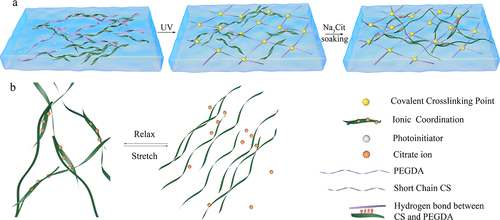当前位置:
X-MOL 学术
›
ACS Biomater. Sci. Eng.
›
论文详情
Our official English website, www.x-mol.net, welcomes your
feedback! (Note: you will need to create a separate account there.)
Three-Dimensional Printed Hydrogels with High Elasticity, High Toughness, and Ionic Conductivity for Multifunctional Applications
ACS Biomaterials Science & Engineering ( IF 5.4 ) Pub Date : 2020-11-30 , DOI: 10.1021/acsbiomaterials.0c01413 Ziwei Deng 1, 2, 3, 4, 5 , Tianbao Qian 1, 2, 3, 4, 5 , Fei Hang 1, 2, 3, 4, 5
ACS Biomaterials Science & Engineering ( IF 5.4 ) Pub Date : 2020-11-30 , DOI: 10.1021/acsbiomaterials.0c01413 Ziwei Deng 1, 2, 3, 4, 5 , Tianbao Qian 1, 2, 3, 4, 5 , Fei Hang 1, 2, 3, 4, 5
Affiliation

|
Hydrogels have drawn extensive attention due to their unique physical and biological properties. However, the relatively low mechanical strength and poor processability of hydrogels limit their applications. Especially, the emerging 3D printing technology for nontoxic hydrogels requires proper formability and controllable mechanical behaviors. In this study, a new strategy to construct a novel double-network biocompatible hydrogel from poly(ethylene glycol) diacrylate (PEGDA) and short-chain chitosan (CS) via ionic–covalent cross-linking is by a two-step method involving UV curing followed by immersion in an anionic solution. The CS-based ionic network and PEGDA-based covalent network as well as the hydrogen bonds between them jointly induce excellent mechanical properties, which can be regulated by changing the PEGDA/CS content and ionic cross-linking time. Compared with conventional hydrogels, this mechanically optimized hydrogel exhibits a superior elastic modulus (3.84 ± 0.4 MPa), higher tensile strength (7.23 ± 0.2 MPa), and higher tensile strain (162 ± 7%). Notably, its excellent printing capability through the citrate anionic solution adjustment enables 3D printing with precision, flexibility, and a complex inner structure by extrusion in air at room temperature. In addition, a number of citrate ions existed in the ionic network, giving the hydrogels good electrical conductivity. Therefore, this printable, conductive, and tough hydrogel exhibits potential for vascular engineering, cartilage tissue engineering, and wearable device applications.
中文翻译:

具有高弹性,高韧性和离子电导率的三维印刷水凝胶,可用于多功能应用
水凝胶因其独特的物理和生物学特性而受到广泛关注。但是,相对较低的机械强度和较差的水凝胶可加工性限制了它们的应用。特别是,新兴的无毒水凝胶3D打印技术要求适当的可成型性和可控的机械性能。在这项研究中,通过离子共价交联由聚乙二醇二丙烯酸酯(PEGDA)和短链壳聚糖(CS)构造新型双网络生物相容性水凝胶的新策略是通过涉及紫外线的两步法固化,然后浸入阴离子溶液中。基于CS的离子网络和基于PEGDA的共价网络以及它们之间的氢键共同诱导出优异的机械性能,可以通过改变PEGDA / CS含量和离子交联时间来调节。与常规水凝胶相比,这种经过机械优化的水凝胶表现出优异的弹性模量(3.84±0.4 MPa),较高的拉伸强度(7.23±0.2 MPa)和较高的拉伸应变(162±7%)。值得注意的是,其通过柠檬酸根阴离子溶液调节而产生的出色打印能力通过在室温下在空气中挤出,可以实现3D打印,具有精确度,灵活性和复杂的内部结构。另外,离子网络中存在大量柠檬酸根离子,使水凝胶具有良好的导电性。因此,这种可印刷,导电且坚韧的水凝胶在血管工程,软骨组织工程和可穿戴设备应用中显示出潜力。这种经过机械优化的水凝胶具有优异的弹性模量(3.84±0.4 MPa),较高的拉伸强度(7.23±0.2 MPa)和较高的拉伸应变(162±7%)。值得注意的是,其通过柠檬酸根阴离子溶液调节而产生的出色打印能力通过在室温下在空气中挤出,可以实现3D打印,具有精确度,灵活性和复杂的内部结构。另外,离子网络中存在大量柠檬酸根离子,使水凝胶具有良好的导电性。因此,这种可印刷,导电且坚韧的水凝胶在血管工程,软骨组织工程和可穿戴设备应用中显示出潜力。这种经过机械优化的水凝胶具有优异的弹性模量(3.84±0.4 MPa),较高的拉伸强度(7.23±0.2 MPa)和较高的拉伸应变(162±7%)。值得注意的是,其通过柠檬酸根阴离子溶液调节而产生的出色打印能力通过在室温下在空气中挤出,可以实现3D打印,具有精确度,灵活性和复杂的内部结构。另外,离子网络中存在大量柠檬酸根离子,使水凝胶具有良好的导电性。因此,这种可印刷,导电且坚韧的水凝胶在血管工程,软骨组织工程和可穿戴设备应用中显示出潜力。通过调节柠檬酸根阴离子溶液的出色打印能力,通过在室温下在空气中挤出,可以实现3D打印,具有高精度,灵活性和复杂的内部结构。另外,离子网络中存在大量柠檬酸根离子,使水凝胶具有良好的导电性。因此,这种可印刷,导电且坚韧的水凝胶在血管工程,软骨组织工程和可穿戴设备应用中显示出潜力。通过调节柠檬酸根阴离子溶液的出色打印能力,通过在室温下在空气中挤出,可以实现3D打印,具有高精度,灵活性和复杂的内部结构。另外,离子网络中存在大量柠檬酸根离子,使水凝胶具有良好的导电性。因此,这种可印刷,导电且坚韧的水凝胶在血管工程,软骨组织工程和可穿戴设备应用中显示出潜力。
更新日期:2020-12-14
中文翻译:

具有高弹性,高韧性和离子电导率的三维印刷水凝胶,可用于多功能应用
水凝胶因其独特的物理和生物学特性而受到广泛关注。但是,相对较低的机械强度和较差的水凝胶可加工性限制了它们的应用。特别是,新兴的无毒水凝胶3D打印技术要求适当的可成型性和可控的机械性能。在这项研究中,通过离子共价交联由聚乙二醇二丙烯酸酯(PEGDA)和短链壳聚糖(CS)构造新型双网络生物相容性水凝胶的新策略是通过涉及紫外线的两步法固化,然后浸入阴离子溶液中。基于CS的离子网络和基于PEGDA的共价网络以及它们之间的氢键共同诱导出优异的机械性能,可以通过改变PEGDA / CS含量和离子交联时间来调节。与常规水凝胶相比,这种经过机械优化的水凝胶表现出优异的弹性模量(3.84±0.4 MPa),较高的拉伸强度(7.23±0.2 MPa)和较高的拉伸应变(162±7%)。值得注意的是,其通过柠檬酸根阴离子溶液调节而产生的出色打印能力通过在室温下在空气中挤出,可以实现3D打印,具有精确度,灵活性和复杂的内部结构。另外,离子网络中存在大量柠檬酸根离子,使水凝胶具有良好的导电性。因此,这种可印刷,导电且坚韧的水凝胶在血管工程,软骨组织工程和可穿戴设备应用中显示出潜力。这种经过机械优化的水凝胶具有优异的弹性模量(3.84±0.4 MPa),较高的拉伸强度(7.23±0.2 MPa)和较高的拉伸应变(162±7%)。值得注意的是,其通过柠檬酸根阴离子溶液调节而产生的出色打印能力通过在室温下在空气中挤出,可以实现3D打印,具有精确度,灵活性和复杂的内部结构。另外,离子网络中存在大量柠檬酸根离子,使水凝胶具有良好的导电性。因此,这种可印刷,导电且坚韧的水凝胶在血管工程,软骨组织工程和可穿戴设备应用中显示出潜力。这种经过机械优化的水凝胶具有优异的弹性模量(3.84±0.4 MPa),较高的拉伸强度(7.23±0.2 MPa)和较高的拉伸应变(162±7%)。值得注意的是,其通过柠檬酸根阴离子溶液调节而产生的出色打印能力通过在室温下在空气中挤出,可以实现3D打印,具有精确度,灵活性和复杂的内部结构。另外,离子网络中存在大量柠檬酸根离子,使水凝胶具有良好的导电性。因此,这种可印刷,导电且坚韧的水凝胶在血管工程,软骨组织工程和可穿戴设备应用中显示出潜力。通过调节柠檬酸根阴离子溶液的出色打印能力,通过在室温下在空气中挤出,可以实现3D打印,具有高精度,灵活性和复杂的内部结构。另外,离子网络中存在大量柠檬酸根离子,使水凝胶具有良好的导电性。因此,这种可印刷,导电且坚韧的水凝胶在血管工程,软骨组织工程和可穿戴设备应用中显示出潜力。通过调节柠檬酸根阴离子溶液的出色打印能力,通过在室温下在空气中挤出,可以实现3D打印,具有高精度,灵活性和复杂的内部结构。另外,离子网络中存在大量柠檬酸根离子,使水凝胶具有良好的导电性。因此,这种可印刷,导电且坚韧的水凝胶在血管工程,软骨组织工程和可穿戴设备应用中显示出潜力。











































 京公网安备 11010802027423号
京公网安备 11010802027423号